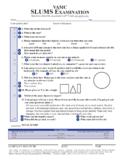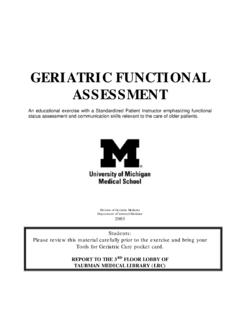Transcription of Semantic Verbal Fluency test in dementia - …
1 Dement Neuropsychol 2009 December;3(4):315-320 Original ArticleLopes M, et al. Semantic Verbal Fluency test in dementia 315 Semantic Verbal Fluency test in dementiaPreliminary retrospective analysisMarcos Lopes1, Sonia Maria Dozzi Brucki2, Viviana Giampaoli3, Let cia Lessa Mansur4 Abstract The Semantic Verbal Fluency (SVF) test entails the generation of words from a given category within a pre-set time of 60 seconds. Objectives: To verify whether socio-demographic and clinical data of individuals with dementia correlate with the performance on the SVF test and to ascertain whether differences among the criteria of number of answers, clusters and data spread over the intervals, predict clinical results.
2 Methods: This was a retrospective study of 49 charts of demented patients classified according to the Clinical dementia Rating (CDR) scale. We correlated education, age and gender, as well as CDR and Mini-Mental State Exam (MMSE) scores with the number of answers, clustering and switching distributed over four 15-second intervals on the SVF test. Results: The correlation between number of answers and quartiles was weak (r= , p= ; r= , p< ) but correlation between the number of clusters and responses was strong (r= , p< ). The number of items on the SVF was statistically significant with MMSE score (p= ) and there was a tendency for significance on the CDR (p= ).
3 The results indicated little activity regarding what we propose to call cluster recalling in the two groups. Discussion: The SVF test, using number of items generated, was found to be more effective than classic screening tests in terms of speed and ease of application in patients with CDR 2 and 3. Key words: Verbal Fluency , evaluation, cognition, de Flu ncia Verbal Sem ntica nas dem ncias: an lise preliminar retrospectivaResumo A Flu ncia Verbal Sem ntica (FVS) requer a gera o de palavras de determinada categoria, num tempo pr -fixado de 60 segundos. Objetivos: Verificar se os dados sociodemogr ficos e cl nicos de indiv duos com dem ncias se correlacionam com a FVS; apontar poss veis diferen as entre crit rios de n mero de respostas, agrupamentos e dados distribu dos nos intervalos predizem resultados cl nicos.
4 M todos: Este um estudo retrospectivo de 49 prontu rios de pacientes com dem ncia, classificados de acordo com a escala de estadiamento de dem ncia (Clinical dementia Rating-CDR). Foram correlacionados os dados de educa o, idade e g nero e CDR e Mini-Exame do Estado Mental (MEEM) ao n mero de respostas, agrupamentos e mudan as de crit rio (switchings) gerados, em quatro intervalos de 15 segundos. Resultados: As correla es entre n mero de respostas, quartis e entre n mero de respostas e de quartis foram baixas (r= , p= ; r= , p< ); por m, a correla o foi alta entre n mero de agrupamentos e de respostas (r= , p< ).
5 O n mero de itens gerados na SVF foi estatisticamente significante com o MMSE (p= ) e houve tend ncia signific ncia no CDR (p= ). Os resultados indicaram pouca atividade daquilo que chamamos de cluster recalling nos dois grupos. Discuss o: A FVS com o crit rio de itens gerados pode ser considerado instrumento cl nico vantajoso em rela o s varreduras cl ssicas, em pacientes com CDR 2 e 3, pela rapidez e facilidade de aplica o. Palavras-chave: flu ncia Verbal , avalia o, cogni o, dem , Department of Linguistics, Faculty of Philosophy, Letters and Humanities of the University of S o Paulo, S o Paulo SP, Brazil.
6 2MD, PhD, Behavioral and Cognitive Neurology Unit, Department of Neurology of the University of S o Paulo School of Medicine and Cognitive Disorders Reference Center (CEREDIC), Hospital das Cl nicas of the University of S o Paulo School of Medicine, and Hospital Santa Marcelina, S o Paulo SP, Brazil. 3 PhD. Department of Statistics Mathematics and Statistics Institute of University of S o Paulo, S o Paulo SP, Brazil. 4 PhD. Department of Physiotherapy, Speech-Pathology and Occupational Therapy of Medicine School of University of S o Paulo, S o Paulo SP, Lopes Av. Prof. Luciano Gualberto 403 - 05508-900 S o Paulo SP - Brazil.
7 E-mail: The authors report no conflicts of interest. Received August 19, 2009. Accepted in final form September 21, 2009 Dement Neuropsychol 2009 December;3(4):315-320316 Semantic Verbal Fluency test in dementia Lopes M, et clinical evaluation of Semantic memory includes the Verbal Fluency test, in which an individual is required to recall items. Variations of this test include the phonemic Verbal Fluency (PVF), free Fluency , Fluency of certain classes of words, alternated Fluency , and Semantic Verbal Fluency (SVF) of different Semantic categories such as animals, food, fruits and supermarket items.
8 Generally, one-minute recuperation time is allowed during tests . The SVF test is a quick, easy-to-apply test which presents high sensitivity and specificity for the diagnosis of dementia , justifying its use to detect cognitive decline, either applied individually or in cognitive evaluation batteries such as the Consortium to Establish a Registry for Alzheimer s disease (CERAD),6 Mattis dementia Rating Scale (DRS)4,5 and Brief Cognitive Screening Battery (BCSB).7 Many authors have reported that age had greater impact on SVF while schooling had no influence on the ,2,4-6,8 With regard to lesions and cognitive repercussions, recent review of the literature on the use of VF in evalu-ations of patients with focal cortical lesions concluded that Semantic Verbal Fluency related to animals was more specific in detecting cognitive alterations resulting from temporal lesions, while PVF more accurately detected defi-cits resulting from frontal lesions.
9 Prior studies using func-tional magnetic resonance in focal lesions, have highlighted the implication of bilateral pre-frontal and dorso-lateral cortices and ventral median areas in ,10 Most stud-ies investigating demented performance on SVF tests have been involved Alzheimer s In Alzheimer s disease (AD), there is progressive disturbance of Semantic memory, attributed to alterations in the inferior-lateral temporal and frontal types of dementia also compromise performance in tasks of Semantic information recall. Not only is Verbal Fluency sensitive for the detection of cognitive alterations, it also aids in the differential diagnoses of AD, vascular de-mentia (VD), mild cognitive impairment and is also useful in follow-up and establishing degree of Furthermore, it has assisted in predicting the course of the disease and can be applied using different methods.
10 The most frequent is tracking the number of items uttered, according to certain Semantic or phonemic criteria, within a pre-set time. Some studies have sought to sensitize Fluency analysis by introducing methods that qualitatively analyze clusters and switching, which has proved productive in evaluat-ing patients with various sub-type dementias. There is however disagreement about clusters and switching and consequently over scoring methods used in the analysis of Fluency results. Tr o y e r17 proposed analyzing sub-category (clusters) and the capacity of changing to a new category when a sub-category has been exhaustively explored (switching).






